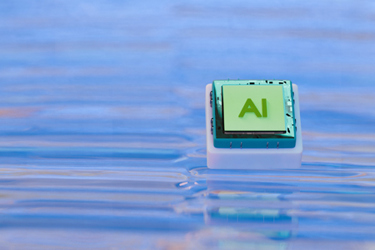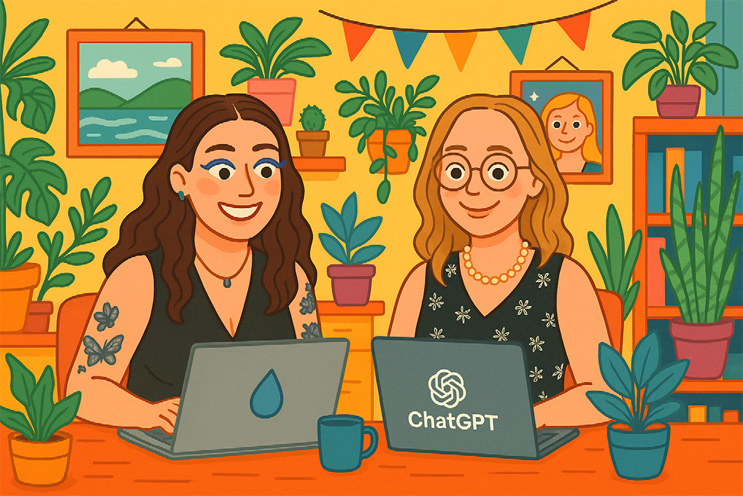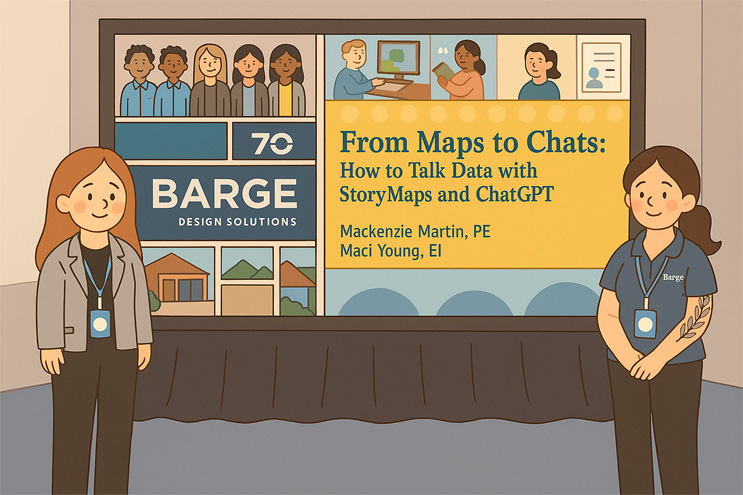From Data To Decisions: AI's New Role In Water Management
By Mackenzie Martin and Maci Young

Engineers are turning to AI to cut weeks of work into hours and sharpen critical decisions.
Artificial intelligence (AI) is transforming industries by streamlining workflows and improving outcomes. Its ability to comprehend complex data sets and automate time-consuming tasks is revolutionizing efficiencies across industries. In water management specifically, AI may be used to help engineers make faster and smarter decisions. At Barge Design Solutions, we are actively integrating AI into our operations, allowing us to analyze and visualize data faster, enhance communication to key stakeholders, and focus on critical decision-making.
This article will explore how water professionals can use AI to transform data into key insights, leveraging tools like Microsoft Copilot and ChatGPT. We will also discuss the ethical considerations for AI and how engineers can use it responsibly and effectively. As AI adoption continues to grow, we highlight innovative applications in hydraulic modeling software and explore integrations that set the stage for the future of AI-driven water management.
Converting Data Into Insights With AI
AI can help transform raw system data into meaningful insights that can support informed decision-making. For example, we leveraged AI tools to analyze raw data from hydraulic model outputs, enabling us to identify optimal tank placement and uncover capacity constraints. From here, we prompted AI to turn the data into charts to help support our claims and communicate them effectively with stakeholders. These insights would have required multiple days or weeks to complete if done manually, but with AI, we completed the work in just a few hours.
AI tools can assist engineers and project managers in analyzing complex data sets more efficiently, enabling them to focus on higher-level decision-making and strategy. This support can lead to stronger project outcomes and cost savings for firms and clients. For example, AI can be used to organize and visualize customer meter data, helping utilities identify areas for operational improvement or potential service concerns. AI-powered assistants can also help record meeting discussions, summarize action items, and provide instant access to historical communications, streamlining collaboration and supporting informed decisions. While AI enhances the data analysis process, it should be used to complement, not replace, engineering judgment and expertise.
Beyond automating everyday tasks, water professionals can also use AI to assist with quality control, document review, and identifying areas for improvement in engineering work. For example, Copilot allows us to quickly search across Barge’s internal engineering resources and quality control documentation to find what we need for engineering work. Additionally, AI tools allow us to prescreen our work before submitting it to quality control teams, resulting in a faster and more efficient review process.
Tools Of The Trade: ChatGPT, Microsoft Copilot, And ArcGIS StoryMaps
As generative AI has become more mainstream, the pool of available tools has continued to expand. Some of the most popular across industries are ChatGPT and Microsoft Copilot. Professionals are regularly leveraging these tools to simplify everyday tasks, like writing an email, summarizing a call, generating reports, etc. For water professionals, there are many use cases for these tools and others to help expedite and enhance our work.
ChatGPT is a generative AI tool that can also be used to generate images and prepare written content for project work. Copilot, a general-purpose AI assistant, can help water engineers summarize lengthy documents, draft polished reports, and generate visuals. Built with the same technology as ChatGPT, Copilot integrates directly with Microsoft’s ecosystem, allowing the user to retrieve key information across Microsoft 365 applications. This is a major time-saver for teams at Barge, as it lets us quickly locate important internal documents such as master specification sheets and project manuals. Additionally, Copilot inherits Microsoft’s secure environment to ensure that all data remains within the organization. This helps teams maintain compliance with company and client confidentiality policies, making it an attractive resource for water professionals.
When paired with storytelling platforms like ArcGIS StoryMaps, these tools can help water engineers create engaging presentations for outside stakeholders, like local government officials or the general public, to easily comprehend. We applied this integration for a water distribution study in east Tennessee, where we used the two platforms to communicate hydraulic model results1 to stakeholders and audiences without an engineering background. This process allowed us to transform complex information into an easy-to-understand webpage that can be shared with anyone.
Starting with ChatGPT, we prompted it to develop an outline for ArcGIS StoryMaps that would explain the study, including why it matters, how data was collected, and the anticipated community benefits. The result was a strong outline that set the stage for an engaging, data-driven presentation. We didn’t just take the output and call it final, though. We verified the outline’s accuracy, adjusted the presentation’s tone and flow, and used ChatGPT to generate supporting images. A project of this scale would typically take days or weeks to complete. With AI, we were able to execute it in just a few hours. While StoryMaps requires software to build, the final product is shared as a simple web link, accessible to anyone with an internet connection. A process like this can be easily implemented across multiple engineering disciplines to communicate project information in a format everyone can understand.

Maci and Mackenzie collaborate on water management solutions using AI tools and StoryMaps, highlighting how technology and teamwork drives innovation in their field.
Checklist: How To Optimize Your Use Of AI
For professionals just getting started with AI tools or those looking to optimize their use, consider the following:
- Follow Experts: Research and follow AI thought leaders on LinkedIn or Substack who regularly share tips and tricks. One of our favorites is Dr. Jules White at Vanderbilt University. He has several courses on AI that cover everything from prompt engineering to AI-enhanced data visualizations, all of which are available on Coursera. You may also consider tuning into webinars or social media groups that discuss AI topics and use cases specific to water engineering.
- Form Focus Groups: Consider forming an internal team at your organization focused on AI. For example, at Barge we’ve created an internal focus group where we discuss AI prompts, recent use cases, and success stories across our divisions. This has been helpful for driving innovation and providing outside perspectives from those working in other disciplines, like architecture, environmental engineering, and more.
- Experiment: Many professionals are initially unsure about AI’s accuracy or relevance, often leading to feelings of AI insecurity — a common misconception that using AI equates to cheating. When used correctly, AI is simply an assistant, not a shortcut. Starting with small tasks and refining prompts can help build confidence. As you become more comfortable, experiment further and tailor the tools to your specific needs and workflows.
Ethical Considerations And Responsible Use Of AI
While there are many benefits to using AI, it’s important to do so in a responsible way that abides by company and industry regulations and policies. Before you start using AI, review your organization’s AI and cybersecurity policies to ensure compliance.
If you regularly use tools like ChatGPT or Google Gemini, consider migrating to Microsoft Copilot or an internal large language model (LLM) provided by your company to ensure data remains secure within your organization’s internal systems. This will help to protect sensitive information and align with set policies for AI use. For example, we use an LLM specifically created for Barge employees. This allows us to access useful company data and materials, while protecting client information and remaining in compliance with our established AI policies.
Remember, AI should be used as a support tool, not a decisionmaker. It’s critical to closely evaluate and validate results and materials generated by AI to ensure accuracy. You can also ask for source references to verify where outputs resulted from.
As water engineers, it’s also important for us to acknowledge water conservation concerns around AI. AI technologies require significant resources to operate effectively, especially water, which is used for cooling data centers. In combination with leveraging AI tools to enhance our work, we should also advocate for improving the technology to better meet sustainability standards.

Maci and Mackenzie present innovative ways to communicate complex water data using AI and storytelling platforms at the 2025 KY-TN Water Professionals Conference. These visuals not only enhance presentations but also demonstrate how AI can support creativity and effective communication in water engineering.
What’s Next For AI In Water Management
As adoption increases, AI will shift from a support tool to a core component of water infrastructure management. In the near future, we expect to see AI used in conjunction with existing tools, like AutoCAD, GIS, and hydraulic modeling software, to enhance speed and accuracy. As AI becomes a core component of water infrastructure management, future innovations must also prioritize environmental responsibility. This includes developing more waterefficient data center technologies and embedding sustainability metrics into AI-driven design workflows.
As we look farther into the future, the next evolution of AI in water management involves creating intelligent agents that assist with design optimization and real-time decision-making. These agents will become embedded in workflows, helping engineers generate more accurate and consistent results faster. In the meantime, there are many AI tools to experiment with to help enhance our work as water engineers.
Refereces:
About The Authors
 Mackenzie Martin, PE, is a civil engineer in the water group at Barge Design Solutions. With a master’s degree in civil engineering and extensive experience in the water sector, Martin is passionate about developing sustainable and efficient solutions for water distribution systems, wastewater management, and environmental conservation. An active member of the Young Professionals and Women in Water Committees of the AWWA, she is committed to fostering professional growth and collaboration within the water industry.
Mackenzie Martin, PE, is a civil engineer in the water group at Barge Design Solutions. With a master’s degree in civil engineering and extensive experience in the water sector, Martin is passionate about developing sustainable and efficient solutions for water distribution systems, wastewater management, and environmental conservation. An active member of the Young Professionals and Women in Water Committees of the AWWA, she is committed to fostering professional growth and collaboration within the water industry.
 Maci Young, EI, is a civil engineer at Barge Design Solutions, where she supports water infrastructure and civil design projects with a focus on resilient, community-centered solutions. She holds a master’s degree in civil engineering and is passionate about making engineering accessible through clear, inclusive communication. Young also serves as co-chair of the Kentucky/Tennessee Clean Water Professionals (CWP) Student Committee, leading outreach and mentorship initiatives to inspire future water professionals.
Maci Young, EI, is a civil engineer at Barge Design Solutions, where she supports water infrastructure and civil design projects with a focus on resilient, community-centered solutions. She holds a master’s degree in civil engineering and is passionate about making engineering accessible through clear, inclusive communication. Young also serves as co-chair of the Kentucky/Tennessee Clean Water Professionals (CWP) Student Committee, leading outreach and mentorship initiatives to inspire future water professionals.
